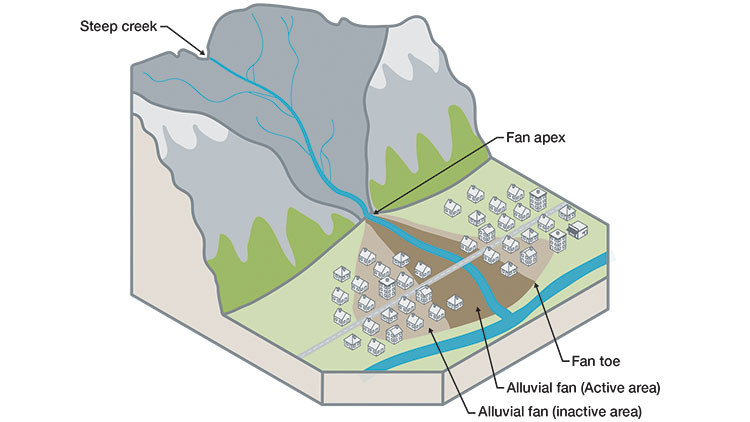Government mail service may be affected by the Canada Post labour disruption. Learn about how critical government mail will be handled.
What alluvial fans are and why they matter
An alluvial fan is a landform that develops from the deposition of sediment and other debris from mountain creeks as they flow from steep terrain to flat, wide valleys. Extreme rainfall and runoff events can transport debris like sediment, rock, trees and vegetation down the mountain and into the valley.
Alluvial fans are dynamic, and their boundaries can change over time. The active areas of the fan experience frequent flooding, which prevents vegetation growth, while less active areas of the fans can be vegetated and support riparian habitats.

Figure 1. Schematic view of an alluvial fan.
The hazards of alluvial fans
Flooding in steep terrain poses unique hazards. Events such as debris flows, and debris floods quickly transport large amounts of debris and water down mountain creeks and can damage or destroy infrastructure along the way. The devastation experienced in the Rocky Mountain region of Alberta, specifically in the Town of Canmore, Kananaskis Improvement District, and Municipal District of Bighorn in 2013 and in Waterton National Park in 2023, are prime examples of the damage that can be caused by such events.
The Government of Alberta manages the production of alluvial fan studies and maps to help Albertans and affected communities understand alluvial fan processes and identify alluvial fan boundaries to anticipate potential hazards.
Alluvial fan physical processes
Basic terms
- Debris is a mixture of unconsolidated material that includes rocks, sediment and organic material such as soil and vegetation.
- Alluvium is sediment and debris of various sizes that is deposited from flowing water.
Common processes and their impacts
Common alluvial fan processes are debris flow, debris flood, and low debris flood.
- Debris flow is a dense, fast-moving, channelized flow of water and debris (similar to wet concrete) that poses a hazard to infrastructure and those living in mountainous environments.
- Debris flood is a flood containing a moderate amount of debris. It is distinguished from a debris flow in that water controls the flow behaviour.
- Low debris flood is a flood with a low amount of debris compared to debris floods. Low debris floods typically occur on creeks that are not steep.
These processes pose significant risk to life and infrastructure from flooding, erosion, debris-impacts, and the formation of new river channels. They can occur suddenly and have the potential to be as or more destructive than river flooding.
More information about alluvial fan terms, processes and hazards is available at:
Alluvial fan inventory
The alluvial fan inventory includes information and boundaries of alluvial fans that may indicate the presence of hazards to infrastructure and Albertans in the mountainous regions of the province. The inventory includes:
- name and location of the fans
- physical properties of the watershed
- physical properties of the fan
- hazard information
The alluvial fans were mapped using a combination of:
- air photo data
- fieldwork
- publicly available imagery
- satellite imagery
The inventory focuses on alluvial fans near populated areas and infrastructure. The inventory is not an exhaustive list of all alluvial fans in the mountainous area of Alberta. Boundaries are approximate as these landforms are dynamic and subject to rapid change.
Resources
- Alberta’s Flood Awareness Map Application
is the best way to view, interact with and get more information about alluvial fans. - Alluvial Fan Inventory Fact Sheet
Find additional information about the alluvial fan inventory.
Stay informed about alluvial fan flood events
- Follow local government bylaws, guidelines, and advisories.
- Check Alberta’s Flood Awareness Map Application to see whether your property is on an alluvial fan.
- Follow the Alberta River Basins website or mobile app for flood advisories.
- Keep an eye on weather forecasts and be prepared with an emergency plan in case you need to evacuate.
- Follow the Alberta Emergency Management Agency for information regarding emergency and disaster prevention, preparedness and responses.